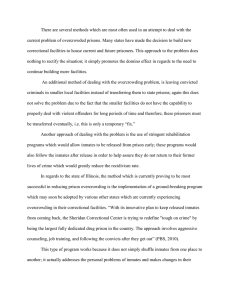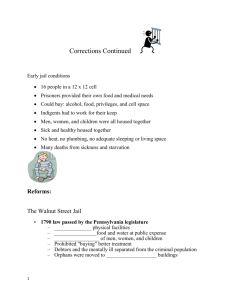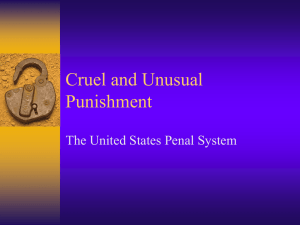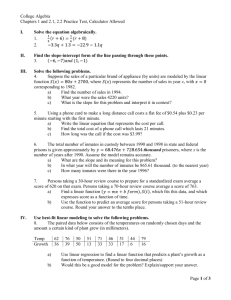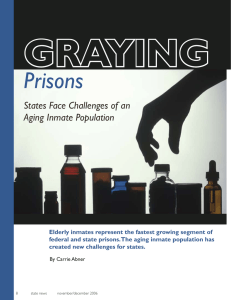AJ 50 – Introduction to Administration of Justice
advertisement
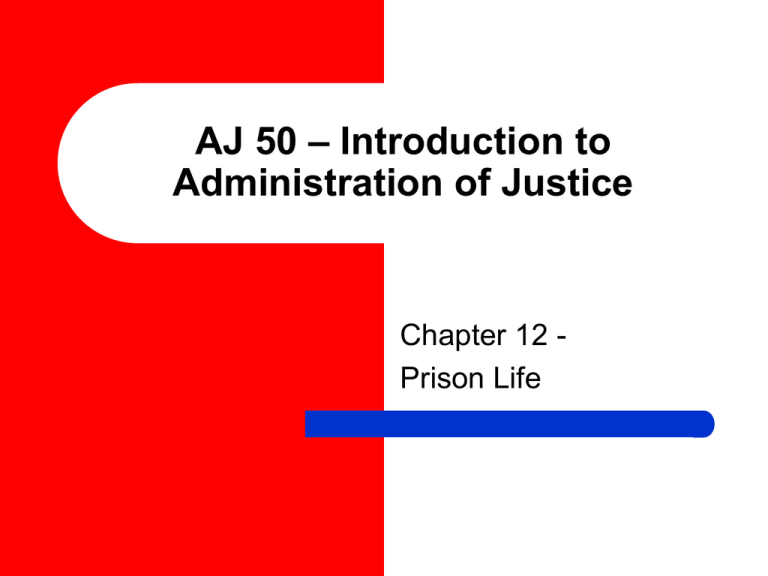
AJ 50 – Introduction to Administration of Justice Chapter 12 Prison Life Research on Prisons Prisons have been the focus of sociological research and media attention for decades Total Institutions – – – Enclosed facilities Physically & socially separated from society Inhabitants share all aspects of daily lives Prison Subculture Values and patterns of behavior that characterize prison inmates – Very consistent across the country Prisonization – Process by which new inmates accept prison lifestyle and criminal values The Prison Code Common rules identified by prison researchers in 1960 – – – – – Don’t interfere/never rat Do your own time Be right Be a man/don’t whine Don’t trust the guards/staff Prison Lifestyle & Inmate Types Violent – – Jailhouse lawyer Coping mechanism Gangbanger – Comfort zone inside Religious – “Political” prisoner Colonizer – Psychological retreat Legalist – Take full advantage Retreatist Radical – Living for the present Opportunist – Survival of the toughest Hedonist – Defense, protection Realist – Doing their time Sexual Victimization Welcome committee for new arrivals – Fight, pay, or serve General conclusions of research… – – – – Most sexual aggressors do not consider themselves as homosexuals Sexual release is not primary motivation Aggressors may continue to participate in gang rapes to avoid victimization Aggressors may have suffered damage to masculinity in the past Female Inmates 112,000 female prison inmates in 2007 Most are in for non-violent crimes – Many share a background of victimization – Drugs and property crimes most common Physical, sexual abuse 80% have substance-abuse problems Female-Inmate Considerations US Prisons are traditionally male-dominated – Inmates, structure, staffing Responding to gender needs… – – – – Separate structure for female inmates Target females’ pathways to criminality and effective intervention programs Recognize low-risk of typical female offender Consider females’ role in family and community during sentencing Corrections Staff Approximately 748,000 corrections employees in US – – – 62% state 33% local 5% federal Socialization process similar to that for inmates Professionalism – – Education & Training standards on the rise Code of Ethics Riots Turbulent period during 1970’s What Causes Riots? – – – – Administration’s ignoring prisoner demands Inmates’ violent nature Poor living conditions inside prison Power struggles between inmate groups Security Threat Group = Group, gang, or organization of inmates who – – – Pose a threat to staff safety Prey on other inmates Threaten orderly operation of facility Riot Control Most riots are spontaneous, unplanned Five typical phases – – – – – Explosion Organization into inmate-led groups Confrontation with authority Termination through negotiation or confrontation Reaction, investigation, and explanation Prisoners’ Rights Hands-Off Doctrine – Pell v Procunier (1974) – Until the 1960’s, US courts tended to stay uninvolved in prison management Inmates retain 1st Amendment rights that are not inconsistent with status as prisoner Balancing Test – Weighs individual rights against restricting authority Prisoners’ Rights (continued) Communications and Visitation Religious Freedom Access to Courts/Legal Assistance Medical Care Protection from Harm Institutional Punishment & Discipline Prisoners With Special Needs AIDS – Geriatrics – 76,500 state & federal inmates over age 55 Mental Illness – 20,450 state & federal inmates infected 283,800 mentally-ill inmates in prisons and jails Terrorism – Active recruiting among certain populations


